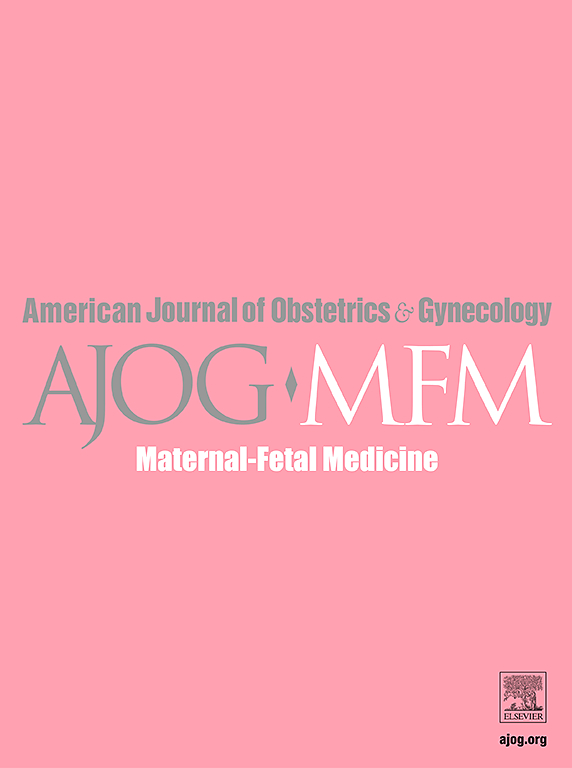视觉辅助引产教育:一项随机对照试验。
IF 3.1
2区 医学
Q1 OBSTETRICS & GYNECOLOGY
American Journal of Obstetrics & Gynecology Mfm
Pub Date : 2025-07-18
DOI:10.1016/j.ajogmf.2025.101743
引用次数: 0
摘要
背景:在美国,大约20%的患者接受人工引产(IOL)。接受引产的患者更有可能报告分娩满意度较低,尤其是黑人患者。视觉辅助已被证明可以提高患者在医疗决策中的满意度,然而,很少有研究调查使用视觉辅助进行人工晶状体咨询。目的:比较人工晶状体引产(IOL)的标准咨询与标准咨询加患者知情的视觉辅助,并评估患者对人工晶状体知识和咨询满意度的差异。研究设计:这是一项随机对照试验,纳入单胎妊娠≥37周接受人工晶状体手术的患者。结果:84例患者随机入组;39%的人认为自己是亚裔、黑人或西班牙裔。视力辅助组和标准咨询组的IOL知识答对正确率相似:中位数80 (IQR 60-90)对中位数70 (60-90),p=0.23。在按历史上被边缘化的种族和民族、保险类型或教育水平分层后,我们观察到各组之间没有显著差异。与常规咨询相比,接受视觉辅助的参与者对咨询的满意度得分相似:9(8-10)对10 (9-10),p=0.08。结论:与标准咨询相比,引入患者知情的助视器并没有改变人工晶状体知识或咨询满意度。未来的方向包括修改视觉辅助使用患者的反馈和评估其在产前护理的早期实施。本文章由计算机程序翻译,如有差异,请以英文原文为准。
Visual aids for induction of labor education: a randomized controlled trial
Background
Approximately 20% of patients in the United States undergo an induction of labor (IOL). Patients undergoing induction are more likely to report lower birth satisfaction, especially Black patients. Visual aids have been shown to improve patient satisfaction in medical decision-making, however, there are few studies investigating the use of visual aids for IOL counseling.
Objective
To compare standard counseling for IOL to standard counseling plus a patient-informed visual aid and evaluate differences in patient knowledge of IOL and satisfaction with counseling.
Study design
This was a randomized controlled trial of patients with singleton gestations ≥37 weeks admitted for IOL. Patients who were <18 years old, non-English speaking, with prior cesareans, fetal anomalies, intrauterine fetal demise, or whose induction agent had already been determined were excluded. We developed a visual aid handout on induction methods with input from patients that had recently undergone an induction. On admission, patients were randomized to routine counseling or counseling with the visual aid. The primary outcome was patient knowledge, using questions adapted from a published IOL knowledge assessment. Our secondary outcome was satisfaction with IOL counseling, rated on 0 to 10 scale. Eighty-four patients (42 in each arm) were required to detect a 25% difference in knowledge scores with 85% power. We used an intention-to-treat approach for our analyses; we compared the percentage of correct answers on the IOL knowledge assessment and satisfaction with IOL counseling using Wilcoxon rank sum. We conducted planned stratified analyses by historically marginalized race, level of education, and insurance type.
Results
Eighty-four patients were randomized; 39% self-identified as Asian, Black, or Hispanic. The percentage of correct IOL knowledge answers were similar between the visual aid group and the standard counseling group: median 80 (IQR: 60–90) versus 70 (60–90), P=.23. We observed no significant differences between groups after stratifying by historically marginalized race and ethnicity, insurance type, or level of education. Satisfaction with counseling scores were similar between participants receiving the visual aid compared to regular counseling: 9 (8–10) versus 10 (9–10), P=.08.
Conclusion
The introduction of a patient-informed visual aid did not change IOL knowledge or satisfaction with counseling compared to standard counseling. Future directions include modifying the visual aid using patient feedback and evaluating its implementation earlier in antenatal care.
求助全文
通过发布文献求助,成功后即可免费获取论文全文。
去求助
来源期刊

American Journal of Obstetrics & Gynecology Mfm
Medicine-Medicine (all)
CiteScore
7.40
自引率
3.20%
发文量
254
审稿时长
40 days
期刊介绍:
The American Journal of Obstetrics and Gynecology (AJOG) is a highly esteemed publication with two companion titles. One of these is the American Journal of Obstetrics and Gynecology Maternal-Fetal Medicine (AJOG MFM), which is dedicated to the latest research in the field of maternal-fetal medicine, specifically concerning high-risk pregnancies. The journal encompasses a wide range of topics, including:
Maternal Complications: It addresses significant studies that have the potential to change clinical practice regarding complications faced by pregnant women.
Fetal Complications: The journal covers prenatal diagnosis, ultrasound, and genetic issues related to the fetus, providing insights into the management and care of fetal health.
Prenatal Care: It discusses the best practices in prenatal care to ensure the health and well-being of both the mother and the unborn child.
Intrapartum Care: It provides guidance on the care provided during the childbirth process, which is critical for the safety of both mother and baby.
Postpartum Issues: The journal also tackles issues that arise after childbirth, focusing on the postpartum period and its implications for maternal health. AJOG MFM serves as a reliable forum for peer-reviewed research, with a preference for randomized trials and meta-analyses. The goal is to equip researchers and clinicians with the most current information and evidence-based strategies to effectively manage high-risk pregnancies and to provide the best possible care for mothers and their unborn children.
 求助内容:
求助内容: 应助结果提醒方式:
应助结果提醒方式:


